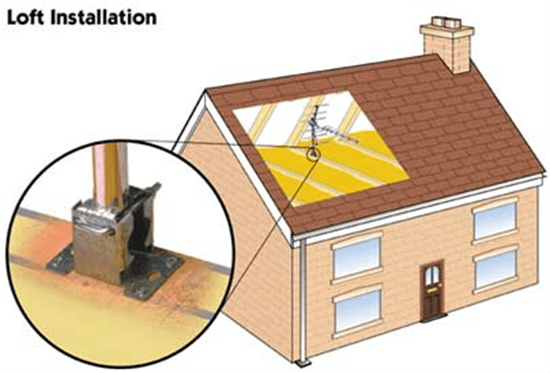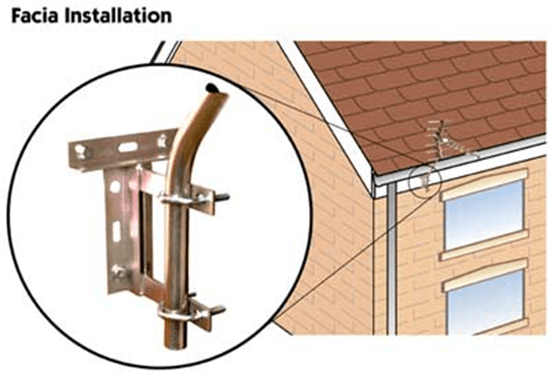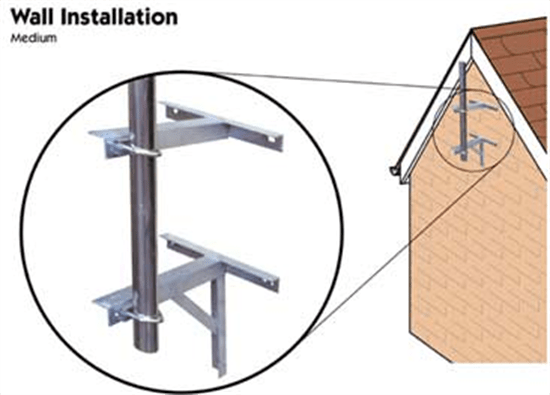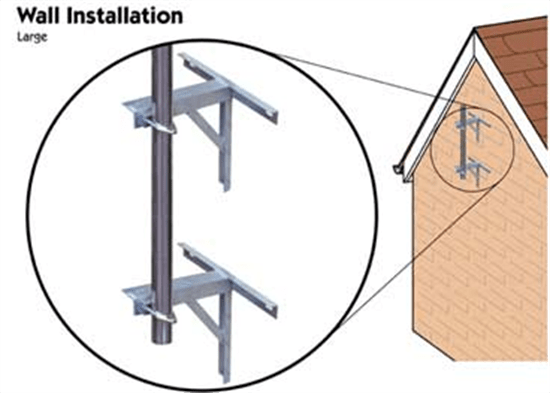Installation Options
Aerial Installation Options For Locating and Fixing
In a typical house or dwelling, several options exist for installing an aerial and bracket.

- Avoid installing the aerial in the centre of the loft space; this is where any reflected signals are most likely to be.
- Do not point the aerial towards water/header tanks; this will greatly reduce the signal level.
- Avoid pointing the aerial towards sidewalls; always try to receive the signal by pointing the aerial towards the roof tiles. Sidewalls will reduce the signal level more than the roof tiles.
- If possible, tilt the aerial back slightly.
- If in doubt regarding any aspect of height safety, always seek professional advice and never increase the risks by taking chances.

- This option does not allow great alignment flexibility of the aerial and is suitable only if there is a line of sight of the transmitter.
- If in doubt regarding any aspect of height safety, always seek professional advice and never increase the risks by taking chances.

- This is the best option for an aerial installation as gives the maximum height that can be achieved without the use of a long mast.
- On larger chimneys, installing a longer mast using the double chimney bracket method is possible.
- The double bracket method is also a good choice for installing a medium/large aerial, as a large aerial installation on a standard single chimney bracket could be damaged in high winds.
- If in doubt regarding any aspect of height safety, always seek professional advice and never increase the risks by taking chances.



- This is the best option for a property without a chimney.
- If a longer-than-usual mast is to be installed, the double wall bracket method is best.
- Always choose the wall that will give the aerial the best line of sight towards the transmitter.
- If in doubt regarding any aspect of height safety, always seek professional advice and never increase the risks by taking chances.
Health and Safety
Your Heath And Safety Must Come first, determine the installation type and assess the risks...
Loft Installation
- Is access to the loft secure and safe?
- Are their roof boards fitted securely for safe movement within the roof space?
- Is there adequate visibility, or will a light be required?
Chimney installation
- Is there access to the chimney with a standard ladder and roof loop ladder (cat ladder)?
- Is the chimney in good condition? Will it withstand the stresses of a bracket and aerial?
- Is the ground level for the ladders, or will packing be required?
- Are there any points where the ladders can be secured?
Wall installation
- Can the wall be accessed easily?
- Can the ladder be secured to a fixed point?
- Is the ground level for the ladders, or will packing be required?
- Ensure no damage will be caused to pipework or electrical cables.
- If the wall is to be drilled, this applies to the drilling required for the bracket AND the routing of cables.
General Safety Precautions, DOs and DON'Ts
DO's
- Do plan the installation and the equipment required.
- Always be aware of other people at ground level.
- Do use good quality ladders with non-slip feet, and check for defects before use.
- Do pack the base of the ladders so that they are not leaning sideways and securely footed to avoid the ladders slipping before use.
- Do position the ladder so that it leans at a slope of 4 vertical to 1 horizontal.
- Do ensure that a person can reach the work from a position 1 m below the top of the ladder
- Ensure that one hand is always on the ladder.
- Ensure that the ladder's top rests against a solid surface; ladders should not rest on fragile or other insecure materials such as cement, sheet, or plastic guttering.
- Ensure that if the ladder cannot be fixed, a second person foots the ladder while it is being used (this also applies while the ladder is being fixed).
- Use a good quality roof loop ladder (cat ladder) when working on sloping roofs.
- Do lash the cat ladder to the roof ladder. If the security of the ridge tiles is in question, use a second cat ladder on the opposite side of the roof and lash to the existing cat ladder.
- Ensure that tools are carried in a shoulder bag or on a holster attached to a belt.
- Do display warning signs, i.e. cones, signs or a red flag if ladders are to be used in thoroughfares.
- Do lay temporary floorboards if working in the loft.
- Do take time on the installation; do not carry too many items up the ladder in one trip.
- Wear the correct safety equipment such as harnesses, fall arrest equipment etc.
DONT's
- Don't attempt to work on unsafe structures. If the structure is visibly unsafe, seek professional advice. If, upon closer inspection, the structure is seen to be unsafe, again, seek professional advice.
- Don't work alone.
- Don't use damaged ladders or equipment.
- Don't use makeshift or homemade ladders or carry out makeshift repairs to a damaged ladder.
- Don't use painted ladders, as the paint may hide faults.
- Don't stand on roof tiles unless absolutely necessary; use the cat ladder or a creeper board to access a chimney.
- Don't fix ladders to uneven ground; use packing to level the ladder.
- Don't climb or work off a ladder unless you can hold onto it.
- Don't use the top platform of a stepladder unless it is designed with special handholds.
- Don't carry items up a ladder that would require using both hands; one hand should always hold the ladder.
- Don't attempt to work on a sloping roof without a good-quality cat ladder or creeper board.
- Don't go on the cat ladder unless it is lashed to the ground ladder.
- Don't use wall type brackets on chimneys, only use brackets that require strapping or lashing fixings.
- Don't fit a chimney bracket on the first two courses of chimney brickwork; always fit to lower courses; use 3 third courses as a minimum.
- Don't throw equipment down to ground level; carry old brackets, cables, poles, and aerials own to the ground.
- Don't modify any safety equipment without the manufacturer's prior agreement.
If in doubt regarding any aspect of height safety, always seek professional advice and never increase the risks by taking chances








 Quick Add
Quick Add